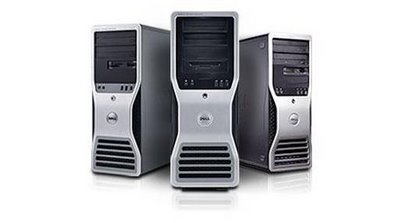Dell officially unveiled its new range of workstation-class systems today with the launch of the Precision T3500, T5500 and T7500. Like all new workstations being announced this week, the new Precision family is based on Intel’s Xeon 5500 Series (Nehalem) architecture, which offers incredible power for multi-threaded applications; particularly those that take advantage of HyperThreading, such as 3ds Max and HyperShot.
Like most of the major workstation vendors, Dell has bypassed Intel’s Core i7 platform for its new Precisions, instead waiting for ECC (Error Correcting Code) memory for better accuracy, which is not supported on Core i7. The new Xeon platform also, uniquely, supports Direct Cache Access (DCA) which enables the cache of inactive cores to be accessed by those that are active.
Dell has expanded its range of graphics options with new cards from Nvidia including the Quadro FX 580, FX 1800 and FX 3800, but has also increased the number of AMD ATI FirePro cards it carries in the range with standard options available on the FirePro V3750, V5700 and V8700. Up to two Quadro FX4800 and FX5800 are available in the high-end T7500.
Acoustics has been a major design concentration for the new Precisions with low duty fans aiding the CFD (Computational Fluid Dynamics) designed airflow. Dell has also done a lot of research into ‘what if’ scenarios, modelling what would happen if one vent was blocked off, for example.
In terms of machine positioning, the single socket T3500 will take up the entry-level role, but Dell will continue to offer the Core 2 Duo-based T3400 for those on incredibly tight budgets. The mid-range T5500 is a particularly interesting machine, specifically because Dell has managed to pack so much technology into such as small chassis. Dell gave DEVELOP3D a sneak preview of the machine and we were astounded by the engineering that has gone into this, with the second processor and memory located at 90 degrees to the motherboard on a riser card. With such a small footprint, however, the T5500 is fairly limited in its expandability and this is where the T7500 fits in with capacity for up 192GB RAM and a ridiculous amount of hard drives. It also includes an on-board SAS controller.
While the new systems will ship with Windows Vista by default, Dell will continue to offer Windows XP downgrades (with XP recovery disks) as well as Linux. However, thorough its custom factory integration program Dell can supply workstations with XP pre-installed, and it is also possible for customers to supply disk images for Operating System, network and applications, which Dell installs prior to shipping.
Dell is also in the process of developing a new Flash-driven workstation advisor website, which is designed to make it easier for customers to choose workstations according to which applications they use. This is coming in Q2 2009.
Look out for review of the new Precision range soon.







